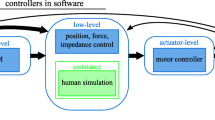Abstract
In this paper we present a new control approach called RISE (Robust Integral of the Sign of Error) to control a three DOF exoskeleton designed at the Lebanese University for the assistance and rehabilitation of the human lower limb. The main purposes of this work are: (1) testing this novel control approach called RISE, (2) testing the gravity balancing design and show its advantages, in simplifying the control system and enhancing its performance. The extension and flexion of the knee joint in a seated position is considered as a case study in three different contexts: a passive rehabilitation, an assistance as needed and a resistive rehabilitation. The human torque acting on the robot is taken into consideration through a sequence of realistic torque generated values. We have shown that the RISE controller ensures a good convergence of the trajectory. By comparing a gravity balanced and unbalanced design, we have proven that the control torque is significantly reduced by the gravity balancing mechanism.
Access this chapter
Tax calculation will be finalised at checkout
Purchases are for personal use only
Similar content being viewed by others
References
Kazerooni, H., Steger, R.: The Berkeley lower extremity exoskeleton. J. Dyn. Syst. Meas. Contr. 128(1), 14–25 (2006)
Garcia, E., Sater, J.M., Main, J.: Exoskeletons for human performance augmentation (EHPA): a program summary. J. Robot. Soc. Jpn. 20(8), 822–826 (2002)
Winter, D.A.: Biomechanics and Motor Control of Human Movement. Wiley, Hoboken, New Jersey, USA (2009)
Kawamoto, H., Lee, S., Kanbe, S., Sankai, Y.: Power assist method for HAL-3 using EMG-based feedback controller. In: 2003 IEEE International Conference on Systems, Man and Cybernetics (SMC’03), pp. 1648–1653. IEEE, Washington, DC, USA (2003)
Fleischer, C., Hummel, G.: Embedded control system for a powered leg exoskeleton. In: Proceedings of the 7th International Workshop held at Technische Universität Berlin, pp. 177–186. Springer, Dordrecht (2006)
Fleischer, C., Wege, A., Kondak. K., Hommel, G.: Application of EMG signals for controlling exoskeleton robots. Biomedizinische Technik 51(5–6), 314–319 (2006)
Wang, Y., Makeig, S.: Predicting intended movement direction using EEG from human posterior parietal cortex. In: Schmorrow, D.D., Estabrooke, I.V., Grootjen, M. (eds). Foundations of Augmented Cognition. Neuroergonomics and Operational Neuroscience. FAC 2009. LNCS, vol. 5638, pp. 437–446. Springer, Berlin, Heidelberg (2009)
Xian, B., Dawson, D.M., de Queiroz, M., Chen, J.: A continuous asymptotic tracking control strategy for uncertain nonlinear systems. IEEE Trans. Autom. Control 49(7), 1206–1211 (2004)
Fischer, N., Hughes, D., Walters, P., Schwartz, E.M., Dixon, W.E.: Nonlinear RISE-based control of an autonomous underwater vehicle. IEEE Trans. Rob. 30(4), 845–852 (2014)
Patre, P.M., MacKunis, W., Kaiser, K., Dixon, W.E.: Asymptotic tracking for uncertain dynamic systems via a multilayer neural network feedforward and RISE feedback control structure. IEEE Trans. Autom. Control 53(9), 2180–2185 (2008)
Rizk, R.: Wearable gravity balanced orthosis for lower limb with a special transmission mechanism. Mech. Mach. Sci. 73, 1545–1555 (2019)
Rizk, R., Krut, S., Dombre, E.: Design of a 3D gravity balanced orthosis for upper limb. In: 2008 IEEE International Conference on Robotics and Automation, pp. 2447–2452. IEEE, Pasadena, CA, USA (2008)
Guenzkofer, F., Engstler, F., Bubb, H., Bengler, K.: Joint torque modeling of knee extension and flexion. In: Duffy, V.G. (eds.) Digital Human Modeling. ICDHM 2011. LNCS, vol. 6777, pp. 79–88. Springer, Berlin, Heidelberg (2011)
Swevers, J., Ganseman, C., Bilgin, D., De Schutter, J., Van Brüssel, H.: Optimal robot excitation and identification. IEEE Trans. Robot. Autom. 13(5), 730–740 (1997)
Author information
Authors and Affiliations
Corresponding author
Editor information
Editors and Affiliations
Rights and permissions
Copyright information
© 2020 Springer Nature Switzerland AG
About this paper
Cite this paper
Roula, N., Rizk, R., Zaouk, D., Farah, W., Francis, Z. (2020). Nonlinear RISE-Based Control for a Gravity Balanced Exoskeleton: Evaluation of the Design and Control Principle. In: Misyurin, S., Arakelian, V., Avetisyan, A. (eds) Advanced Technologies in Robotics and Intelligent Systems. Mechanisms and Machine Science, vol 80. Springer, Cham. https://doi.org/10.1007/978-3-030-33491-8_1
Download citation
DOI: https://doi.org/10.1007/978-3-030-33491-8_1
Published:
Publisher Name: Springer, Cham
Print ISBN: 978-3-030-33490-1
Online ISBN: 978-3-030-33491-8
eBook Packages: Intelligent Technologies and RoboticsIntelligent Technologies and Robotics (R0)




